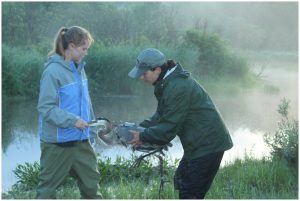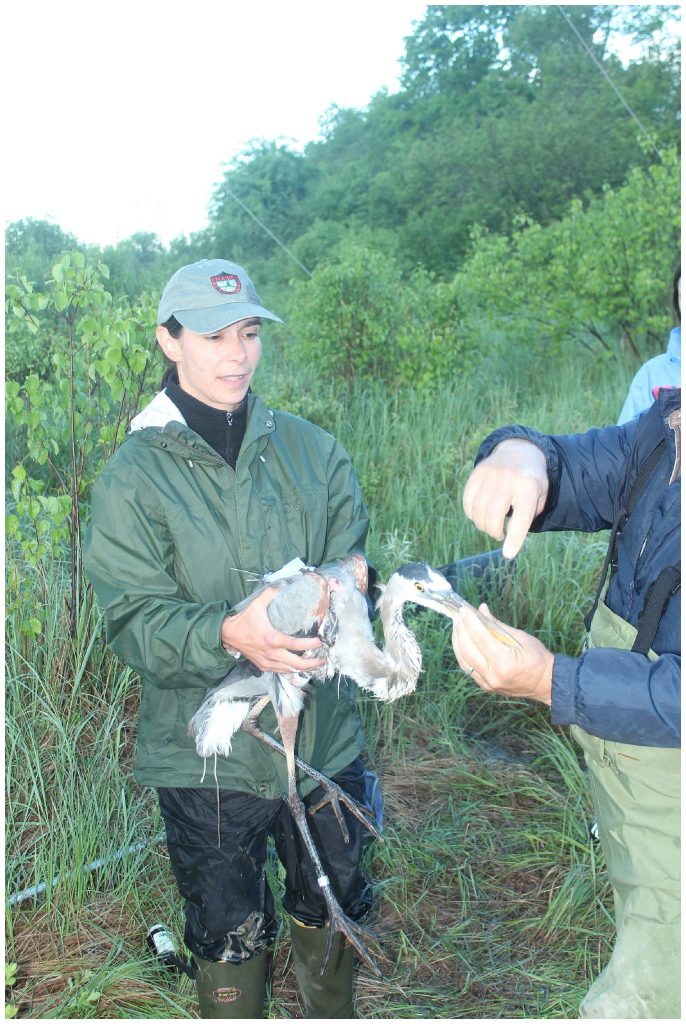June 8, 2016 at 3:34 pm
 Students and teachers from several schools across the state, in conjunction with the Maine Department of Inland Fisheries and Wildlife, are capturing and radio tagging great blue herons to learn more about herons and their habitats.
The student’s jobs, equipped with binoculars, minnow traps, and fish ID cards, is to locate a foraging heron in their area and then catch fish to use as bait to keep the herons coming back to the site. IFW wildlife biologist Danielle D’Auria, and a small team of researchers will then capture the herons using foothold traps set near the bait, and tag each bird with a GPS transmitter to monitor their movements for years to come.
[caption id="attachment_1552" align="alignright" width="339"]
Students and teachers from several schools across the state, in conjunction with the Maine Department of Inland Fisheries and Wildlife, are capturing and radio tagging great blue herons to learn more about herons and their habitats.
The student’s jobs, equipped with binoculars, minnow traps, and fish ID cards, is to locate a foraging heron in their area and then catch fish to use as bait to keep the herons coming back to the site. IFW wildlife biologist Danielle D’Auria, and a small team of researchers will then capture the herons using foothold traps set near the bait, and tag each bird with a GPS transmitter to monitor their movements for years to come.
[caption id="attachment_1552" align="alignright" width="339"] A trail camera captures images of herons visiting the bait site[/caption]
The project is just one part of IFW’s ongoing research into the state’s great blue heron population. By marking and following individual adults over several years, IFW will gather new information regarding Maine’s herons. The great blue heron is a Species of Special Concern for IFW due to the decline in the number of nesting pairs on Maine’s coastal islands from the 1980s to 2007. In order to learn more about great blue heron daily movements, habitat use, colony fidelity, migration routes, and wintering locations, the department began a citizen science adopt-a-colony program called the Heron Observation Network. This new study will augment findings from that program.
The GPS transmitters on the herons transmit GPS locations via the cell phone network to an open source website (www.movebank.org). Being solar-powered, they are expected to provide at least three years of data for each tagged heron. Fully charged, the units collect 288 GPS points and 360 behavioral (accelerometry) tracings per 24-hr period. The data will be made public on www.movebank.org for the students and other citizens of Maine to use in education and to help in making management decisions. There is also a free app called “Animal Tracker” that allows anyone to track the birds (and other species) on a smartphone.
[caption id="attachment_1551" align="aligncenter" width="621"]
A trail camera captures images of herons visiting the bait site[/caption]
The project is just one part of IFW’s ongoing research into the state’s great blue heron population. By marking and following individual adults over several years, IFW will gather new information regarding Maine’s herons. The great blue heron is a Species of Special Concern for IFW due to the decline in the number of nesting pairs on Maine’s coastal islands from the 1980s to 2007. In order to learn more about great blue heron daily movements, habitat use, colony fidelity, migration routes, and wintering locations, the department began a citizen science adopt-a-colony program called the Heron Observation Network. This new study will augment findings from that program.
The GPS transmitters on the herons transmit GPS locations via the cell phone network to an open source website (www.movebank.org). Being solar-powered, they are expected to provide at least three years of data for each tagged heron. Fully charged, the units collect 288 GPS points and 360 behavioral (accelerometry) tracings per 24-hr period. The data will be made public on www.movebank.org for the students and other citizens of Maine to use in education and to help in making management decisions. There is also a free app called “Animal Tracker” that allows anyone to track the birds (and other species) on a smartphone.
[caption id="attachment_1551" align="aligncenter" width="621"] Students assist Biologist Danielle D'Auria by catching minnows for the bait bins[/caption]
D’Auria is working with Dr. John Brzorad of Lenoir-Rhyne University in North Carolina who has been using these same transmitters since 2013 and has paired nearly 20 birds (great egrets and great blue herons) with school systems in five other states.
In Maine, the students involved in this spring’s field work range in level from grades 1-12 and are from the following schools: White Pine Programs in York, Harpswell Community School, Gray-New Gloucester High School, Nokomis High School in Newport, Old Town High School, Haworth Academic Center in Bangor, and Center Drive School in Orrington. After the birds are tagged, D’Auria hopes to get students from every town in Maine following the great blue herons online and using the data generated by the solar-powered backpack transmitters in their classrooms.
Students assist Biologist Danielle D'Auria by catching minnows for the bait bins[/caption]
D’Auria is working with Dr. John Brzorad of Lenoir-Rhyne University in North Carolina who has been using these same transmitters since 2013 and has paired nearly 20 birds (great egrets and great blue herons) with school systems in five other states.
In Maine, the students involved in this spring’s field work range in level from grades 1-12 and are from the following schools: White Pine Programs in York, Harpswell Community School, Gray-New Gloucester High School, Nokomis High School in Newport, Old Town High School, Haworth Academic Center in Bangor, and Center Drive School in Orrington. After the birds are tagged, D’Auria hopes to get students from every town in Maine following the great blue herons online and using the data generated by the solar-powered backpack transmitters in their classrooms.
 Students are currently busy setting and checking minnow traps, identifying and measuring the baitfish caught, and placing the baitfish into a bait bin to see if a heron will feed from it. They are using game cameras to “watch” the bait bins when they cannot be there themselves. This is all being done in anticipation of the arrival of Brzorad and a few colleagues later this month, who will work with D’Auria to capture the herons. When the traps are set, the researchers will watch from a blind until a heron steps into one of the traps. They will then quickly retrieve the bird to take measurements and a blood sample for sexing, and attach the transmitter. As soon as the bird is released, the data collection begins, and the students can start following and learning from “their” bird.
Students are currently busy setting and checking minnow traps, identifying and measuring the baitfish caught, and placing the baitfish into a bait bin to see if a heron will feed from it. They are using game cameras to “watch” the bait bins when they cannot be there themselves. This is all being done in anticipation of the arrival of Brzorad and a few colleagues later this month, who will work with D’Auria to capture the herons. When the traps are set, the researchers will watch from a blind until a heron steps into one of the traps. They will then quickly retrieve the bird to take measurements and a blood sample for sexing, and attach the transmitter. As soon as the bird is released, the data collection begins, and the students can start following and learning from “their” bird.
 For more information on the Heron Tracking Project, including how to follow the great blue herons once they are tagged and resources for educators interested in using the data in their classrooms, visit http://www.maine.gov/wordpress/ifwheron/tracking-project/.
For more information on the Heron Tracking Project, including how to follow the great blue herons once they are tagged and resources for educators interested in using the data in their classrooms, visit http://www.maine.gov/wordpress/ifwheron/tracking-project/.